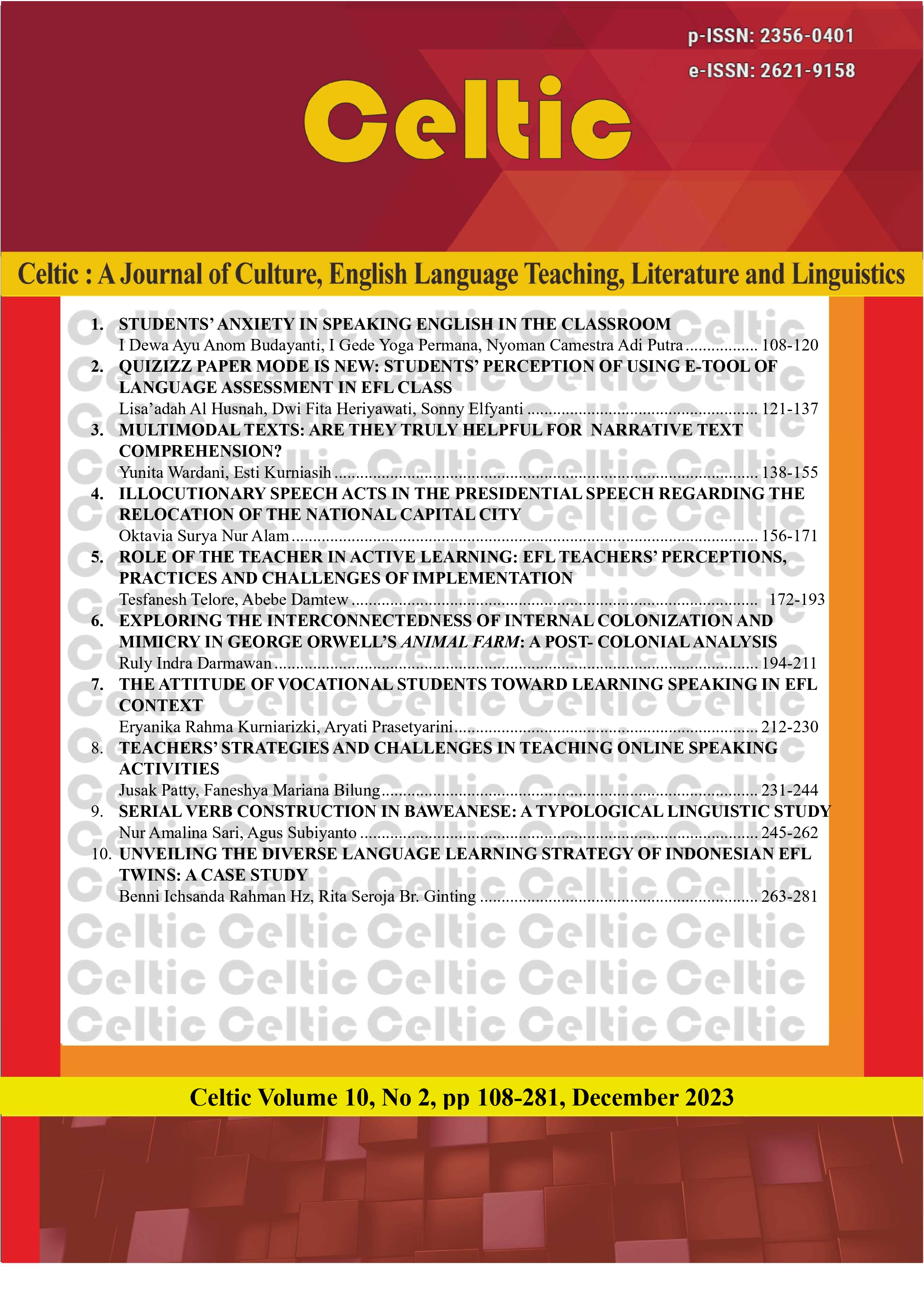TEACHERS’ STRATEGIES AND CHALLENGES IN TEACHING ONLINE SPEAKING ACTIVITIES
DOI:
https://doi.org/10.22219/celtic.v10i2.25494Abstract
This study examines the strategies used by vocational education teachers to teach speaking skills online. Specifically, it focuses on English teachers Vocational High School in Ambon and their challenges in implementing these strategies. The study aims to provide practical insights for teaching speaking skills in online vocational high schools and recommend teacher professional development. The research design involves qualitative research methods, including interviews with two English teachers who teach third-grade Nursing students. The interviews were conducted to gather information on the teachers’ strategies and challenges in teaching speaking skills online. The collected data were analyzed using qualitative analysis techniques. The findings indicate that the teachers used dialogue, describing pictures, and drilling as strategies for teaching speaking skills online. Teachers also faced technical and pedagogical challenges in implementing these strategies. Technical challenges included internet reliability, limited device access, and teachers’ technological proficiency. Pedagogical challenges involved limited student-teacher interaction, reduced student engagement, and the asynchronous nature of online platforms. This study contributes valuable insights into teaching speaking skills in online vocational high schools. The findings can inform instructional practices and guide teacher professional development programs to enhance online speaking instruction.
Downloads
References
Agustina, T. (2014). English for Specific Purposes (ESP): An Approach of English Teaching for Non-English Department Students. Beta: Jurnal Tadris Matematika, 7(1), 37–63. https://doi.org/10.20414/betajtm.v9i2.7
Akbari, O., & Razavi, A. (2015). Using Authentic Materials In The Foreign Language Classrooms: Teachers’ Perspectives in EFL Classes. International Journal of Research Studies in Education, 4(5). https://doi.org/10.5861/ijrse.2015.1189
Ally, M. (2004). Foundations of Educational Theory for Online Learning. In T. Anderson & F. Elloumi (Eds.), Theory and Practice of Online Learning (pp. 24–27). Athabasca University.
Ardiyansah, T. Y. (2021). Pre- Service Teachers ’ Perceived Readiness in Teaching Online in International Internship Program. Celtic: A Journal of Culture, English Language Teaching, Literature and Linguistics, 8(1), 90–102. https://doi.org/10.22219/CELTIC.V8I1.16456
Bui, H. P. (2022). Students and Teachers’ Perceptions of Effective ESP Teaching. Heliyon, 8(9). https://doi.org/10.1016/j.heliyon.2022.e10628
Chapelle, C., & Jamieson, J. (2008). Tips for Teaching with CALL : Practical Approaches to Computer-Assisted Language Learning.
Cresswell, J. W., & Creswell, J. D. (2018). Research Design: Qualitative, Quantitative and Mixed Methods Approaches (Fifth Edit). SAGE Publication, Inc.
Efriana, L. (2021). Problems of Online Learning during Covid-19 Pandemic in EFL Classroom and the Solution. JELITA: Journal of English Language Teaching and Literature, 2(1), 2721–1916. https://jurnal.stkipmb.ac.id/index.php/jelita/article/view/74/52
Farah, R. R., & Sholikhah, N. M. (2021). English Learning and Teaching are Like a Rollercoaster: Metaphor of Online Learning amid COVID-19 Outbreak in Indonesia. Eralingua: Jurnal Pendidikan Bahasa Asing Dan Sastra, 5(2), 388. https://doi.org/10.26858/eralingua.v5i2.17378
Farrah, M. A. A., & Jabari, S. "Mohammad G. (2020). Interaction in Online Learning Environment during Covid -19: Factors behind Lack of Interaction and Ideas for Promoting it. Bulletin of Advanced English Studies, 5(2), 47–56. https://doi.org/10.31559/BAES2020.5.2.3
Hasibuan, I., Hasibuan, I. R., Panjaitan, A. B. J., & Saragih, E. (2022). Speaking Teaching Strategies Used by Vocational School EFL Teacher. English Language in Focus (ELIF), 4(2), 136. https://doi.org/10.24853/elif.4.2.136
Hayati, A. R., Afriani, Z. L., & Akbarjono, A. (2021). Teacher’s Teaching Strategies in EFL Class. Jadila: Journal of Development and Innovation in Language and Literature Education, 1(3), 330–341. https://doi.org/10.52690/jadila.v1i3.126
Hodges, C., Moore, S., Lockee, B., Trust, T., & Bond, A. (2020). The Difference Between Emergency Remote Teaching and Online Learning. Educause. https://er.educause.edu/articles/2020/3/the-difference-between-emergency-remote-teaching-and-online-learning
Huang, R., Tlili, A., Chang, T. W., Zhang, X., Nascimbeni, F., & Burgos, D. (2020). Disrupted Classes, Undisrupted Learning during COVID-19 Outbreak in China: Application of Open Educational Practices and Resources. Smart Learning Environments, 7(1). https://doi.org/10.1186/s40561-020-00125-8
Lavalle, P., & Briesmaster, M. (2017). The Study of the Use of Picture Descriptions in Enhancing Communication Skills among the 8th-Grade Students—Learners of English as a Foreign Language. I.e.: Inquiry in Education, 9(1). https://digitalcommons.nl.edu/ie/vol9/iss1/4
Maro, R. K. (2018). Drilling Technique : A Study of Improving Speaking Skill for Non Scholars in Short Term. English Education: Jurnal Tadris Bahasa Inggris, 11(1), 148–161. https://doi.org/10.24042/ee-jtbi.v11i1.2674
Miles, M. B., Huberman, A. M., & Saldaña, J. (2014). Qualitative Data Analysis: A Methods Sourcebook (3rd Edition). In Jurnal Penelitian Pendidikan Guru Sekolah Dasar (Vol. 6, Issue August).
Mulyanti, S., Nadrun, & Waris, A. (2021). Teachers’ Strategies in Teaching Speaking at High School. Journal of Foreign Language and Educational Research, 4(2), 1–11. https://doi.org/10.31934/JOFLER.V4I2.1673
Novitasari, Wahyuningsih, N., & Agustin, H. N. (2022). Improving Students’ Speaking Skills Through CLIL in Tourist Guiding Online Class. Celtic: A Journal of Culture, 9(1), 53–68. https://doi.org/10.22219/CELTIC.V9I1.20903
Pratiwi, Z. F., & Ayu, M. (2020). The Use of Describing Picture Strategy to Improve Secondary Students’ Speaking Skills. Journal of English Language Teaching and Learning, 1(2), 38–43. https://doi.org/10.33365/jeltl.v1i2.603
Rawung, I. Y. (2021). Teaching English Process through Dialogue Technique at SMP Negeri I Poso. SintuwumarosoJET, 7(2), 75–81. https://ojs.unsimar.ac.id/index.php/sintuwumarosoJET/article/view/413/384
Redjeki, G. P. D., & Hapsari, A. (2022). EFL Undergraduate Students’ Online Self-Regulated Learning Strategies during COVID-19 Pandemic. Celtic : A Journal of Culture, English Language Teaching, Literature and Linguistics, 9(1), 82–96. https://doi.org/10.22219/CELTIC.V9I1.21066
Rosalina, E., Nasrullah, N., & Elyani, E. P. (2020). Teacher’s Challenges towards Online Learning in Pandemic Era. LET: Linguistics, Literature and English Teaching Journal, 10(2), 71. https://doi.org/10.18592/let.v10i2.4118
Sari, C. R., & Zainil, Y. (2020). Teachers’ Strategies in Teaching Speaking English at SMA N 15 Padang. Journal of English Language Teaching, 9(4), 733–739. https://doi.org/10.24036/JELT.V9I4.110335
Scrivener, J. (2011). Learning Teaching: The Essential Guide to English Language Teaching (A. Underhill (ed.); Third Edit). MacMillan Education.
Segbenya, M., Bervell, B., Minadzi, V. M., & Somuah, B. A. (2022). Modelling the Perspectives of Distance Education Students towards Online Learning during COVID-19 Pandemic. Smart Learning Environments, 9(1). https://doi.org/10.1186/s40561-022-00193-y
Sudrajat, I., & Apriliani, H. (2022). Teachers’ Strategies and Challenges in Teaching Speaking to Young Learners. JELA (Journal of English Language Teaching, Literature and Applied Linguistics), 4(1), 1–9. https://doi.org/10.37742/JELA.V4I1.71
Tamala, Y. P., & Wulandari, S. (2021). The Strategies of Teaching Speaking at Junior High School. Journal of Foreign Language and Educational Research, 4(2), 12–24. https://doi.org/10.31934/JOFLER.V4I2.1896
Tanveer, B., Akhter, S., Muhmmad Awais, H., Hussain Qureshi, A., & Awais, M. (2021). Improving Speaking Skills Through Dialouges In Efl Classroom At Higher Secondary Level. PalArch’s Journal of Archaeology of Egypt / Egyptology, 18(4), 2861–2872. https://archives.palarch.nl/index.php/jae/article/view/6725
Tuan, N. H., & Mai, T. N. (2015). Factors Affecting Students’ Speaking Performance at Le Thanh Hien High School. Asian Journal of Educational Research, 3(2), 8–23.
Ulfah, M. (2011). Th Effectiveness of Using Dialogue Technique in Teaching Simple Present Tense: A Pre-Experimental Study at the First Grade of the Students in MTsN Tangerang II Pamulang. Syarif Hidayatullah State Islamic University.
Ur, P. (2012). A Course in English Language Teaching. In A Course in English Language Teaching. https://doi.org/10.1017/9781009024518
Wulandari, R. (2012). The Use of Pictures to Improve the Students’ Speaking Ability of XI IS 2 of SMA N 1 Kasihan in the Academic Year of 2011/2012. Yogyakarta State University.
Zaim, M., Refnaldi, R., & Rahmiyanti, R. (2019). Students’ Perceptions on Teachers’ Teaching Strategy and Their Effects towards Students’ Achievement. International Journal of Research in Counseling and Education, 4(1), 28. https://doi.org/10.24036/00207ZA0002
Zakaria, N., Hashim, H., & Yunus, M. M. (2019). A Review of Affective Strategy and Social Strategy in Developing Students’ Speaking Skills. Creative Education, 10(12), 3082–3090. https://doi.org/10.4236/ce.2019.1012232
Downloads
Published
How to Cite
Issue
Section
License
Copyright (c) 2023 Jusak Patty, Faneshya Mariana Bilung

This work is licensed under a Creative Commons Attribution-ShareAlike 4.0 International License.
- Authors retain copyright to publish without restrictions and grant the journal right of first publication with the work simultaneously licensed under a Creative Commons Attribution License that allows others to share the work with an acknowledgement of the work's authorship and initial publication in this journal.
- Authors are able to enter into separate, additional contractual arrangements for the non-exclusive distribution of the journal's published version of the work (e.g., post it to an institutional repository or publish it in a book), with an acknowledgement of its initial publication in this journal.
- Authors are permitted and encouraged to post their work online (e.g., in institutional repositories or on their website) prior to and during the submission process, as it can lead to productive exchanges, as well as earlier and greater citation of published work.














